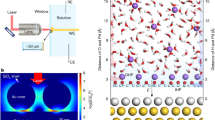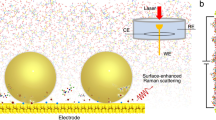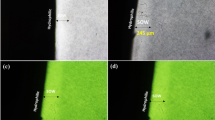Abstract
IN a previous communication (NATURE, Nov. 16, 1929) the peculiar changes in the Raman bands for water in solutions of nitric acid were mentioned. Work with many other strong electrolytes, acids, bases, and salts, has confirmed this behaviour. Study of the bands with ice and with water at higher temperatures has revealed interesting features connected with this. Pure water gives three bands corresponding to infra-red wave-lengths of about 3.12, 2.93, and 2.79 π, which are diffuse and merge into one another. In electrolytic solutions, however, these three bands become sharper with increasing concentration of the electrolyte. The band corresponding to 3.12 π gradually diminishes in intensity until, in very concentrated solutions, it entirely disappears. On the other hand, the band corresponding to 2.79 π, which is the weakest of the three in pure water, becomes stronger in intensity with increasing proportion of the electrolyte, until, in very strong solutions, it becomes equal in intensity to the central band, which is the most intense of the three in pure water.
This is a preview of subscription content, access via your institution
Access options
Subscribe to this journal
Receive 51 print issues and online access
$199.00 per year
only $3.90 per issue
Buy this article
- Purchase on SpringerLink
- Instant access to full article PDF
Prices may be subject to local taxes which are calculated during checkout
Similar content being viewed by others
Author information
Authors and Affiliations
Rights and permissions
About this article
Cite this article
RAMAKRISHNA RAO, I. Raman Effect in Water. Nature 125, 600 (1930). https://doi.org/10.1038/125600b0
Issue date:
DOI: https://doi.org/10.1038/125600b0



